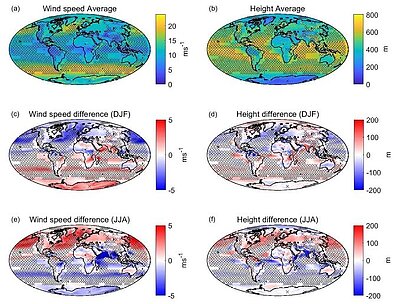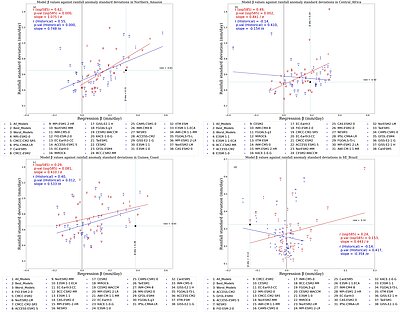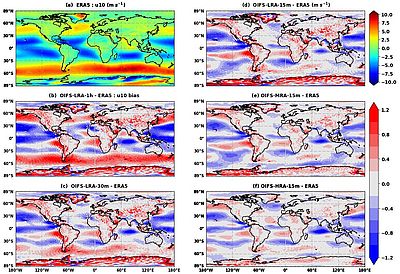Mai 2024:
neue Veröffentlichung:
Luiz, E. W., & Fiedler, S. (2024) Global climatology of low-level-jets: Occurrence, characteristics, and meteorological drivers. Journal of Geophysical Research: Atmospheres, 129, e2023JD040262. https://doi.org/10.1029/2023JD040262
Abstract: In this study, we investigated low-level jets (LLJs), and strong winds in the lower atmosphere that have significant environmental and societal impacts. Using a comprehensive weather data set spanning from 1992 to 2021, we created a global map of LLJs, categorizing them into three regions: non-polar land (LLLJ), polar land (PLLJ), and coastal (CLLJ). LLJs associated with temperature inversions were very common over land, but PLLJs were much more frequent. PLLJs were also the strongest and lowest. Coastal LLJs were prevalent on west coastlines and exhibited changing vertical temperature characteristics. On average, LLJs occurred 21% of the time globally, with higher frequencies over land (32%) compared to the ocean (15%). Regional trends in LLJ frequency and intensity varied, with some areas experiencing more intense LLJs without changes in frequency while others presented an increase in both. The study emphasized the uncertainty surrounding the influence of LLJs on climate and weather extremes in a warming world, with future research aiming at exploring LLJ trends and their broader implications.

Spatial patterns of LLJ characteristics. Shown are the averages of the (a) wind speeds and (b) heights in the core of LLJs calculated as composite means over all detected LLJs, and (c–f) the differences in the characteristics in the mean for December, January, and February (DJF), and for June, July, and August (JJA) relative to the annual means shown in (a) and (b). The dashed areas mask regions where the LLJ frequency of occurrence was smaller than 15%. The results are based on ERA5 for 1992–2021.
Mai 2024:
neue Veröffentlichung:
Nworgu, U. C., H.C. Nnamchi & N. Rosario (2024). Divergent future change in South Atlantic Ocean Dipole impacts on regional rainfall in CMIP6 models. Environmental Research: Climate. 3, https://doi.org/10.1088/2752-5295/ad3a0e.
Abstract:
The South Atlantic Ocean Dipole (SAOD) exerts strong influence on climate variability in parts of Africa and South America. Here we assess the ability of an ensemble of 35 state-of-the-art coupled global climate models to simulate the SAOD impacts on regional rainfall for the historical period (1950–2014), and their future projections (2015–2079). For both periods we consider the peak phase of the dipole in austral winter. Observational analysis reveals four regions with spatially coherent SAOD impacts on rainfall; Northern Amazon, Guinea Coast, Central Africa, and Southeast Brazil. The observed rainfall response to the SAOD over Northern Amazon (0.31 mm d), Guinea Coast (0.38 mm d), and Southeast Brazil (0.12 mm d) are significantly underestimated by the modeled ensemble-mean response of 0.10 ± 0.15 mm d, 0.05 ± 0.15 mm d, −0.01 ± 0.04 mm d, respectively. A too southerly rain belt in the ensemble, associated with warmer-than-observed Atlantic cold tongue, leads to better performance of models over Central Africa (46% simulate observations-consistent SAOD-rainfall correlations) and poor performance over the Guinea Coast (only 5.7% simulate observations-consistent SAOD-rainfall correlations). We also find divergent responses among the projections of ensemble members precluding a categorical statement on the future strength of the SAOD-rainfall relationship in a high-emissions scenario. Our results highlight key uncertainties that must be addressed to enhance the value of SAOD-rainfall projections for the affected African and South American countries.

SAOD influence on rainfall as a predictor of the total rainfall variability in historical (blue) and SSP585 (red) over (a) Northern Amazon, (b) Central Africa, (c) Guinea Coast, and (d) Southeast Brazil. The blue (red) data points and regression lines represent model historic (SSP585) scenarios. The black dots show the observations while the skyblue dotted lines indicate the Observations regression β (horizontal) and rainfall variability (vertical) values.
März 2024:
neue Veröffentlichung:
Savita, A., Kjellsson, J., Pilch Kedzierski, R., Latif, M., Rahm, T., Wahl, S., and Park, W.: Assessment of climate biases in OpenIFS version 43r3 across model horizontal resolutions and time steps, Geosci. Model Dev., 17, 1813–1829, https://doi.org/10.5194/gmd-17-1813-2024, 2024.
Summary: "We examine the impact of horizontal resolution and model time step on the climate of the OpenIFS version 43r3 atmospheric general circulation model. A series of sim- ulations for the period 1979–2019 are conducted with vari- ous horizontal resolutions (i.e. ∼ 100, ∼ 50, and ∼ 25 km) while maintaining the same time step (i.e. 15 min) and us- ing different time steps (i.e. 60, 30, and 15 min) at 100 km horizontal resolution. We find that the surface zonal wind bias is significantly reduced over certain regions such as the Southern Ocean and the Northern Hemisphere mid-latitudes and in tropical and subtropical regions at a high horizon- tal resolution (i.e. ∼ 25 km). Similar improvement is evident too when using a coarse-resolution model (∼ 100 km) with a smaller time step (i.e. 30 and 15 min). We also find im- provements in Rossby wave amplitude and phase speed, as well as in weather regime patterns, when a smaller time step or higher horizontal resolution is used. The improvement in the wind bias when using the shorter time step is mostly due to an increase in shallow and mid-level convection that enhances vertical mixing in the lower troposphere. The en- hanced mixing allows frictional effects to influence a deeper layer and reduces wind and wind speed throughout the tropo- sphere. However, precipitation biases generally increase with higher horizontal resolutions or smaller time steps, whereas the surface air temperature bias exhibits a small improvement over North America and the eastern Eurasian continent. We argue that the bias improvement in the highest-horizontal- resolution (i.e. ∼ 25 km) configuration benefits from a combination of both the enhanced horizontal resolution and the shorter time step. In summary, we demonstrate that, by re- ducing the time step in the coarse-resolution (∼ 100 km) OpenIFS model, one can alleviate some climate biases at a lower cost than by increasing the horizontal resolution."

(a) Annual mean ERA5 surface zonal wind [m s−1]. (b–d) Annual mean zonal wind [m s−1] bias for different model time steps (1 h (b), 30 m (c), and 15 m (d)) using ∼ 100 km resolution and (e, f) with different horizontal resolutions (∼ 50 (e) and ∼ 25 km (f)). Biases are computed with respect to ERA5 over the period 1979–2019.


